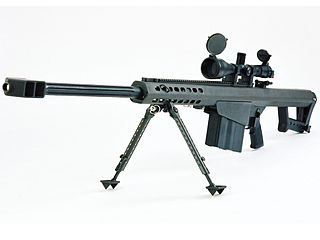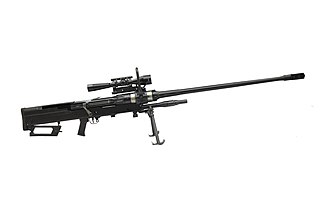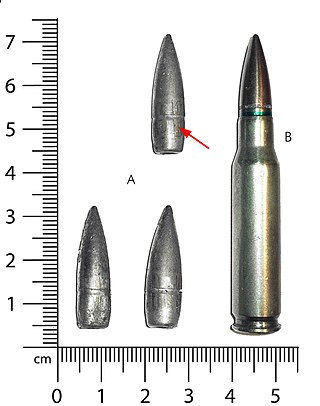Related Research Articles

The 5.56×45mm NATO is a rimless bottlenecked intermediate cartridge family developed in the late 1970s in Belgium by FN Herstal. It consists of the SS109, L110, and SS111 cartridges. On 28 October 1980, under STANAG 4172, it was standardized as the second standard service rifle cartridge for NATO forces as well as many non-NATO countries. Though they are not entirely identical, the 5.56×45mm NATO cartridge family was derived from and is dimensionally similar to the .223 Remington cartridge designed by Remington Arms in the early 1960s.

The IMI Galil is a family of Israeli-made automatic rifles chambered for the 5.56×45mm NATO and 7.62×51mm NATO cartridges. Originally designed by Yisrael Galili and Yakov Lior in the late 1960s, the Galil was first produced by the state-owned Israel Military Industries and is now exported by the privatized Israel Weapon Industries.

This is a table of selected pistol/submachine gun and rifle/machine gun cartridges by common name. Data values are the highest found for the cartridge, and might not occur in the same load.

An anti-materiel rifle (AMR) is a rifle designed for use against military equipment, structures, and other hardware (materiel) targets. Anti-materiel rifles are chambered in significantly larger calibers than conventional rifles and are employed to eliminate equipment such as engines and unarmored or lightly armored targets. While modern armored vehicles are resistant to anti-materiel rifles, the extended range and penetration still has many modern applications. While not intended for use against human targets, the bullet weight and velocity of anti-materiel rifles gives them exceptional long-range capability even when compared with designated sniper rifles. Anti-materiel rifles are made in both bolt-action as well as semi-automatic designs.

The Vektor R4 is a 5.56×45mm assault rifle designed in 1979 based on the IMI Galil rifle. It entered service as the standard service rifle of the South African Defence Force (SADF) in 1980. The R4 replaced the R1, a variant of the 7.62×51mm FN FAL. It was produced by Lyttelton Engineering Works, now Denel Land Systems.

The .303 British or 7.7×56mmR, is a .303-inch (7.7 mm) calibre rimmed rifle cartridge. The .303 inch bore diameter is measured between rifling lands as is the common practice in Europe which follows the traditional black powder convention.

The South African National Defence Force (SANDF) comprises the armed forces of South Africa. The commander of the SANDF is appointed by the President of South Africa from one of the armed services. They are in turn accountable to the Minister of Defence and Military Veterans of the Defence Department.

The NTW-20 is a South African anti-materiel rifle, developed by Denel Mechem in the 1990s. It is intended for deployment against targets including parked aircraft, telecommunication masts, power lines, missile sites, radar installations, refineries, satellite dishes, gun emplacements, bunkers, and personnel, using a range of specialised projectiles. As with other weapons of this type, it can also be used for counter sniping and ordnance disposal.

Armscor, the Armaments Corporation of South Africa is the arms procurement agency of the South African Department of Defence. It was originally established in 1968 as an arms production company, primarily as a response to the international sanctions by the United Nations against South Africa due to apartheid which began in 1963 and were formalised in 1977.

A headstamp is the markings on the bottom of a cartridge case designed for a firearm. It usually tells who manufactured the case. If it is a civilian case it often also tells the caliber: if it is military, the year of manufacture is often added.

The KSVK 12.7 or Degtyarev sniper rifle is a 12.7mm anti-materiel rifle developed in Russia for the purpose of counter sniping and penetrating thick walls, as well as light armored vehicles.

The 14.5×114mm is a heavy machine gun and anti-materiel rifle cartridge used by the Soviet Union, the former Warsaw Pact, modern Russia, and other countries.

The RT-20 is a Croatian bullpup anti-materiel rifle developed by Metallic in Rijeka in the mid-1990s and marketed by RH-Alan. It was developed to shoot the thermal sights on Serbian M-84 and T-72 tanks. The name itself is an acronym of the Croatian word Ručni Top 20, or "Hand Cannon 20mm". Operating with a bolt action, it houses a single 20mm round and must be reloaded after each shot. Given its large caliber, it is one of the most powerful anti-materiel rifles currently in use by any country and is comparable to the South African Denel NTW-20 and the Indian Vidhwansak, with the difference being that the RT-20 is recoilless.
The Gepárd anti-materiel rifles are a family of Hungarian weapons manufactured by Sero International designed to destroy unarmored and lightly armored targets. These long-range large-caliber rifles have high accuracy and muzzle velocity. In 1987 the Hungarian People's Army sought to obtain a compact, mobile weapon that could damage lightly armored targets. The project, led by Ferenc Földi, culminated in the creation of the Gepárds.

Denel Land Systems is a division of the Denel group.

Vidhwansak is an Indian multi-caliber anti-materiel rifle (AMR) or large-caliber sniper rifle manufactured by Ordnance Factory Tiruchirappalli. It can be used in the anti-materiel role for destroying enemy bunkers, lightly armoured vehicles, radar systems, communication equipment, parked aircraft, fuel storage facilities, etc. It is also effective in long-range sniping, counter sniping and ordnance disposal roles.
The 6mm Musgrave was a rifle cartridge invented by Ben Musgrave and introduced by Musgrave Rifles in 1969

The Anzio 20mm rifle is an American anti-materiel rifle designed and marketed by Anzio Iron Works. It is the first American anti-materiel rifle designed and mass-produced for public sale with a bore diameter in excess of .50 caliber in over 80 years. The rifles are available in three calibers, with the rifle's predominant chambering being the 20mm Vulcan caliber.

The 7.62×51mm NATO is a rimless, bottlenecked rifle cartridge. It is a standard for small arms among NATO countries.
References
- ↑ "Denel PMP also in dire straits". defenceWeb. 2 August 2021. Retrieved 28 August 2021.
- ↑ "Pretoria Metal Pressings, Division of Denel (Pty) Ltd. (South Africa)". afte.org. Retrieved 28 August 2021.
- ↑ "Ammunition Headstamp Code: SAM". 6 September 2017. Archived from the original on 6 September 2017. Retrieved 28 August 2021.
- ↑ "South African History of Coins". 28 November 2011. Archived from the original on 28 November 2011. Retrieved 28 August 2021.
- ↑ "Police's ammunition crisis finally resolved". www.iol.co.za. Retrieved 28 August 2021.
- ↑ "Denel PMP assets up for sale". defenceWeb. 10 July 2020. Retrieved 28 August 2021.
- ↑ Recent arms deliveries from the successor States of the former Yugoslavia (PDF). International Peace Information Service.
- ↑ "Pretoria Metal Pressings (PMP), Division of Denel (Pty) Ltd. (South Africa)". afte.org. Retrieved 28 August 2021.
- ↑ "PMP receives first contract for Neopup personal area weapon". defenceWeb. 14 October 2015. Retrieved 28 August 2021.
- ↑ "Sniper rifle NTW-20 (South Africa) Small arms Arsenal". topgun.rin.ru. Retrieved 28 August 2021.